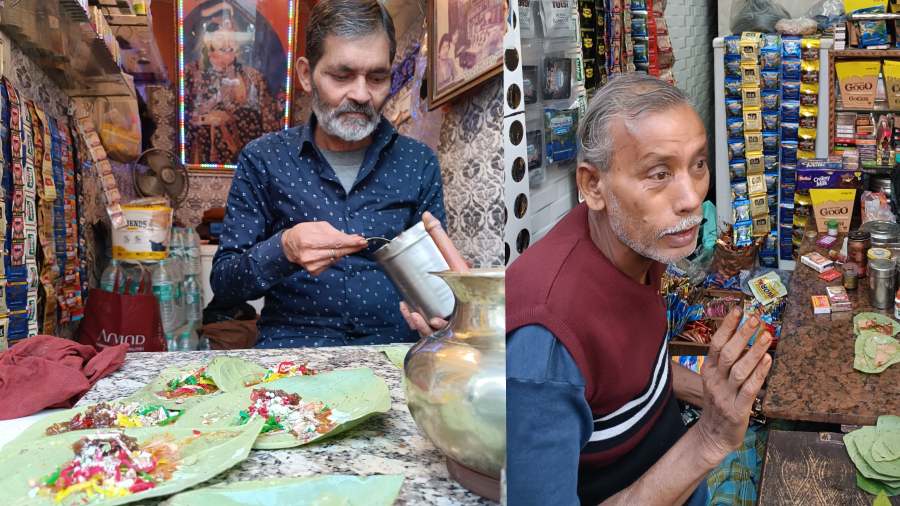Just off Bichali Ghat, close to the main bazaar of Metiabruz in southwest Calcutta, there are two paanwalas who claim their forefathers used to serve Nawab Wajid Ali Shah, the 11th and last ruler of Awadh. “My grandfather’s grandfather, Narottam Saini, came here from Lucknow and settled down,” says Ramesh Kumar Saini, who is a homeopath besides being the owner of this 170-year-old shop.
Right beside Saini’s shop, in an adjoining kiosk, Anand Kishore Chaurasia is diligently laying out an overlapped row of heart-shaped, emerald-hued leaves. He smears them with milky chuna (slaked lime) and reddish brown kattha or catechu, throws in slivers of supari and candied cherry, adds some sticky, green and translucent yellow syrup. Then come the aromatics — chaman bahar with its distinctive effervescence, the ubiquitous paan masala, sweet-smelling mithi supari, ilaichi (cardamom), saunf (fennel seeds) and the candied rose or gulkand on top.
The shop looks like any other paan stall. Small and medium-sized tin and stainless steel jars, glass bottles filled with red, yellow, green syrups, a couple of jars. But should you look up, you will see a large framed photograph of Wajid Ali Shah in all his finery. There is another, much smaller frame, and from it peeps out an elderly man. Chaurasia insists it is his great great-grandfather though he cannot quite recall his name.
As he folds the green leaf with intricate finger movements before pushing it into a golden cone, Chaurasia adds, “I can prepare 50 different kinds of paan.” His special paan, also known as dilkhusha paan, is made only when pre-ordered and is priced at Rs 1,000 per piece. According to Saini, dilkhusha paan is the one “nawab sahab” used to have. It apparently made him very merry.
So what went into a dilkhusha to guarantee a royal mood lift? The story goes that the nawab liked his paan with kesar, kasturi, chandi bhasm or silver powder, sona bhasm or gold powder, coral powder, exotic roots and fresh herbs.
Sudipta Mitra, who has written the book Pearl by the River — which is really the story of the last decades of Wajid Ali Shah spent in Metiabruz — has a paan story. It seems, one day Raja Rupendra Krishna Deb of the famed Sovabazar Rajbari of north Calcutta paid the nawab a visit. Says Mitra, “It was a cold night but to his surprise the raja found his host wearing a light embroidered cloak. He could see the nawab’s bare chest through the finely-made attire as he had not worn any warm clothing underneath either. ‘Aren’t you feeling cold?’ the raja asked. The nawab smiled and replied, ‘Not really, because I am chewing a paan!’” And so saying, the nawab offered his guest a paan.
When the time came for the raja to take leave, he expressed a desire to have another paan. The nawab cautioned him against it but when the raja insisted, he offered him his paandaan.
The raja picked up a second one and started chewing. By the time his carriage reached what is now known as the Maidan, he started feeling hot. The story goes that despite the winter chill, he had the windows of the coach thrown open, removed his woollen shawl and one by one all his warm clothes.
Says Mitra, “Such was the might of the Lucknavi paan!”
There are many paanwalas in and around Metiabruz who claim they are Banarasi paanwalas. Says Saini, “It probably happened with the 1978 Hindi film Don, the one
in which Amitabh Bachchan sang Khaike paan Banaraswala. It became a popular way of marketing paan. But paan-making is a science. Paan was consumed not because it kept a person happy and merry. It has digestive properties.”
When Wajid Ali Shah lived in Lucknow, there were doctors attached to the royal kitchen. “They had a very detailed knowledge about herbs that could be added to food,” adds Saini.
Neither Chaurasia nor Saini has forgotten their Lucknavi roots. “We still have ancestral property in Lucknow but we do not have any connection with that city. This shop is not so much my livelihood as it is my heritage,” explains Saini even as two teenagers patiently await their turn. Says one of them, “He is a moody man, but makes great paan. He has a great memory too. I don’t have to tell him what I want every time, he remembers that for each returning customer.”
Unlike Saini, for Chaurasia the shop earns him his daily bread. “I make nearly 1,000 paans a day. And dilkhusha paan only when there is a wedding. After all, it is a nawabi paan, made with fresh herbs and cannot be stored for too long.”











